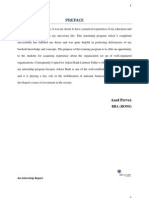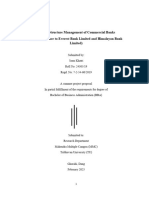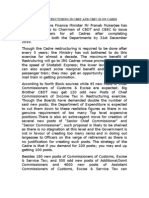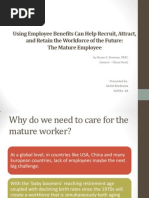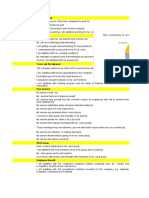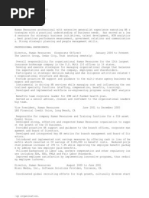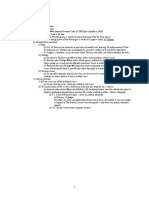Ahmad
Ahmad
Uploaded by
zeinab1234Copyright:
Available Formats
Ahmad
Ahmad
Uploaded by
zeinab1234Original Title
Copyright
Available Formats
Share this document
Did you find this document useful?
Is this content inappropriate?
Copyright:
Available Formats
Ahmad
Ahmad
Uploaded by
zeinab1234Copyright:
Available Formats
World Journal of Social Sciences Vol. 1. No. 4. September 2011. Pp.
195-206
A Comparison of Intrinsic and Extrinsic Compensation Instruments: The Case of National Bank of Pakistan (NBP), District Attock, Pakistan
2 Ahmad Jamal Tahir1, Rosman Bin Md. Yusoff , Anwar Khan3, Kamran Azam4, Muhammad Sohaib Ahmed5 and Muhammad Zohair Sahoo6
The paper aims to compare the compensation instruments which are used as the factors of motiv a tion in the banking sector of Pakistan. With a case study research design, structured interviews were conducted from the fifty ( 5 0 ) employees of NBP branches in district Attock. The responses of interview were scaled and scored according to standardized Likert technique, in such a way that scores for each response were added and then multiplied with total responses. After obtaining scores of the nine compensation factors, Pearson Product correlation was calculated to check the relationship between the compensation factors. The results show that the employees of National Bank of Pakistan were motivated both by the intrinsic as well extrinsic factors of compensation, in such way that extrinsic factors were more causing motivation. The paper has concluded that Compensation Management has a profound direct positive relationship with employee motivation level and intrinsic factors played important role in the motivation process. The paper recommends that public sector banks shall apply progressive human resource strategy and provide healthy compensation plans regarding benefits and intrinsic factors.
Field of Research: Human Resource Management
1. Introduction
The financial assets of a company have always occupied central importance whenever it has come to management decisions. However worlds recent plunge into financial crisis has raised this importance to critical level. This has particularly put direct effect upon financial sector such as banks. The fact that organizations cannot control their external environment in current period of recession has put direct emphasis
1
MBA Student: National University of Computer and Emerging Sciences, Islamabad , Pakistan. Email: akhona_mattata@yahoo.com 2 Associate Professor and Deputy Dean (Academics) at Department of Management, Faculty of Management and Human Resource Development, University Technology, Malaysia. Email: drrosman@gmail.com 3 Lecturer: COMSATS Institute of Information Technology, Attock, Pakistan. PhD Student: Faculty of Management and Human Resource Development, University Technology, Malaysia. Email: anwar_khan@comsats.edu.pk 4 Assistant Professor: Department of Management Sciences, IQRA National University, Peshawar, Pakistan. PhD Student: Faculty of Management and Human Resource Development, University Technology, Malaysia. Email: kamranazamkhan@yahoo.com 5 Student BS(BA) at COMSATS Institute of Information Technology, Attock, Email : saybee_87@yahoo.com 6 MBA Student: Shaheed Zulfiqar Ali Bhutto Institute of Sciences and Technology, Islamabad, Pakistan., Email: zohair_sahoo@hotmail.com
Tahir, Yusoff, Khan, Azam, Ahmed & Sahoo
on management of internal environment of such organizations. Compensation management deals with the ability to effectively compensate the employees to work, and create a competitive advantage through highly motivated human resources (HR). Compensation is the cornerstone of an effective talent management strategy. The ability to enable consistent, reliable and standardized compensation processes that is linked to performance drivers of individual and organizational strategies can affect many facets of the business. Some of these facets include: (1) Improved employee morale and retention, (2) Increased employee engagement and productivity, (3) Strengthened governance and compliance with company and regulatory issues. Motivation is the set of reasons that determines one to engage in a particular behavior, having phenomenological and physiological dimensions. The term is generally used for human motivation but, theoretically, it can be used to describe the causes for animal behavior as well. This article refers to human motivation. According to various theories, motivation may be rooted in the basic need to minimize physical pain and maximize pleasure, or it may include specific needs such as eating and resting, or a desired object, hobby, goal, state of being, ideal (Paul R Kleinginna and Anne M Kleinginna, 1981). Employee satisfaction helps the company to maintain a standard & increase productivity by motivating the employees. As "human resource" is the most important resource for any organization, so to study on employee satisfaction helps to know the working conditions & what are the things that affect them to work properly or otherwise. These factors become really crucial when we talk about financial institutions that have nothing more than services and that also of financial basis to attract their customers. In this condition it becomes really important for them to deal in an effective and committed way to their customers. Because they have no real brand names to back them up, and also customers feel very protective while dealing with financial products, services or institutions. The strength of any financial service provider lies in it human resources. It is logical that if you have a strength that can be your competitive advantage and is directly related towards your operations it will help in evading your threats in external environment. A satisfied and motivated workforce will have convincing influence upon customers and can attract them even in most gruesome conditions as we can find nowadays.
2. Overview of the Banking Sector in Pakistan
Pakistan is a developing country, and being a developing country the recent financial crunch has the worst impact over it. Where developed countries like America and that of European Union managed to sustain their financial institutions through the strength of their governments. But it is evident that countries like Pakistan lack such 196
Tahir, Yusoff, Khan, Azam, Ahmed & Sahoo
government strength. So businesses and especially financial institutions in a country like Pakistan has no hope to control the effect of any such calamities through bailing out by factors like government from their external environment. So then what they must do? It is the question that has to arise. We have already discussed the problem of financial institutions for lacking any strong brand and having sensitive customers. In this scenario financial institutions may only count on the strength of their internal environment. Strength of their own backs, as we may quote it. Observing financial sector of Pakistan, it becomes clear that banking sector dominates it. Banking sector for Pakistan has been somewhat static and slow moving for decades, until government let go of all banks except National Bank of Pakistan in private hands. This started a new revolution in banking sector, with changes erupting in almost every aspect of private banks. This brought about a serious competitive environment in the banking sector. But with all the positive impacts it also brought some big question marks and doubts. Doubts regarding employees and customer satisfaction. Question marks about who is the best. But with financial crunch these doubts have changed to which bank can survive, and who can still have trust of its customers. In banking sector if one name cant be ignored then it is National Bank of Pakistan, The bank that has not only the largest branch network nationwide but also in foreign country, largest reserves, highest authority, and strong corporate brand position with government backing. Before going further into our topic lets have some information about National Bank. National Bank has a vision of To be recognized as a leader and a brand synonymous with trust, highest standards of service quality, international best practices and social responsibility. Its Mission statement is NBP will aspire to the values that make NBP truly the Nation's Bank by Institutionalizing a merit and performance culture, Creating a distinctive brand identity by providing the highest standards of services, Adopting the best international management practices, Maximizing stake holders value, and Discharging our responsibility as a good corporate citizen of Pakistan and countries where we operate. National Bank of Pakistan was established under the NPB ordinance in 1949 and was 100% govt.-owned. NBP acted as an agent of the Central Bank wherever the State Bank did not have its own Branch. It also undertook Government Treasury operations. Its first branches were in jute growing areas in East Pakistan. Offices in Karachi and Lahore followed. In1950 NBP established a branch in Jeddah, Saudi Arabia. By this time NBP had branches in London and Calcutta, in 1955. In1957 NBP established a branch in Baghdad, Iraq. In 1962 NBP established a branch in Dar-es-Salaam, Tanganyika. In 1964 The Iraqi government nationalized NBP's Baghdad branch. In 1965 the Indian government seized the Calcutta branch on the outbreak of hostilities between India and Pakistan. In 1967 The Tanzanian government nationalized the Dar-Es-Salaam branch. In 1971 NBP acquired Bank of China's two branches, one in Karachi and one at Chittagong. At separation of East Pakistan NBP lost its branches there. NBP merged with Eastern Mercantile Bank and with Eastern Bank Corporation. In 1974 the government of Pakistan nationalized NBP. As part of the concomitant consolidation of the banking sector, NBP acquired Bank of Bahawalpur (est. 1947). In 1977 NBP opened an offshore brain 197
Tahir, Yusoff, Khan, Azam, Ahmed & Sahoo
Cairo. In 1994 NBP amalgamated Mehran Bank (est. 1991). In 1997 NBP's branch in Ashgabat, Turkmenistan commenced operations. In 2000 NBP opened a representative office in Almaty, Kazakhstan. In 2001 State Bank of Pakistan and Bank of England agree to allow only 2 Pakistani banks to operate in the UK. NBP and United Bank agreed to merge their operations to form Pakistan International Bank, of which NBP would own 45% and United Bank 55%. Also that year, NBP closed its branch in New York. In 2002 Pakistan International Bank renamed itself United National Bank Limited (Ilhan Gunbayi, 2009). The ownership structure of the UNB remained as before. The only change to the shareholding structure is that UBL had recently been privatized in Pakistan and was now owned 49% by the Government of Pakistan and 51% by a joint foreign consortium of Abu Dhabi. In 2003 NBP received permission to open a branch in Afghanistan. In 2005 NBP closed its offshore branch in Cairo. Today NBP has 1450 domestic branches nationwide spread over 23 regional segmentation. It has assets up to 350 billion rupees (NBP, 2011). Nowadays Business environment have entered in such an intense competitive state that management have to emphasize with utmost concentration on each and every function of organization. Nowadays every aspect can be utilized as competitive advantage and if a company neglects it then competitor would surely adopt it. Human Resource is also a vital function of business, and in most cases we find HR at the base of a companys operations, because it is employees who carry out all the functions of the company. Therefore HR is an important resource as well as primary choice for competitive advantage.
3. Problem Statement
This paper will look in to the perspective of compensation management system in banking sector by knowing about what motivates employees in baking sector. Nowadays banks have become extremely decentralized in nature and due to privatization of banks the level of competition has entered in a new dynamic phase, which directly has its effects over employees of banks. Continuous increasing market demands have literally over loaded employees of banking sector and stretched their working hours in an absurd way. All of this has resulted in employee complaints about work pressure, stress, strain, lack of fulfilling family expectations etc which really have a bad impact over employee motivation of banking sector and ultimately their performance. To handle this situation banks are using different compensation (both intrinsic & extrinsic) and reward policies for motivating their employees. The question is whether banks are applying the appropriate compensation strategies with respect to their employees? Are these strategies achieving the desired results? Which type of compensation has more motivational effects? These issues if remained unaddressed then can lead to problems like demotivation, dissatisfaction of employees and customer, high turnover etc and therefore needs to be studied with care.
198
Tahir, Yusoff, Khan, Azam, Ahmed & Sahoo 4. Research Objectives
The paper will find out different aspects of a compensation system having motivational effects by finding what employees perceive to be the most motivating factor in their compensation system by the assessment of instruments used for extrinsic as well as extrinsic compensation through checking the effectiveness of different intrinsic instruments regarding job satisfaction and motivation to work among the employees of National Bank of Pakistan, Attock city.
5. Literature Review
Swinton (2006) described a relationship between Maslows hierarchy of needs with Herbergz theory. Maslows theory state a persons needs hierarchy with basic needs at base followed by security needs, social needs, esteem needs and self actualization needs. She is of the opinion that up to esteem needs level employee motivation or satisfaction can be maintained by factors which Herbergz called hygiene factors. This includes salary, benefits, job security, company policy etc while to deal with people at self actualization level factors known as motivators would be needed. This includes employee achievement, employee recognition, and employee growth. By keeping in mind this relationship among two basic theories of management organization may find it easy to manage their HR and other operations. Kridan and Goulding (2006) are of the view that knowledge management system could play an integral part in increasing any organizations performance and can help it to compete in such highly competitive environment as todays. They say that knowledge management system if applied can bring improvements in decision making, increase in customer value, improving relationships with consumers and bringing new value in to sight by including the concept of innovation. Sureshchandar et al (2002) in their research studied banking sector of India and analyzed how different banks apply concept of total quality service in their functions. They found that these applications are inconsistent and incongruent with in all banks. Which makes it highly sophisticated sector. According to them banks of India can be divided into three groups based upon their perception about total quality services in operations. Barney and Wright (1997) describe that although human resources are accepted to be organizations most important assets yet organizations decision often depicts contradiction with this belief. They further say that HR should not be neglected b e c a u s e t h e y can bring competitive advantage to organization. Therefore they should be managed with equal importance with other functions of the business. Huselid (1995) has emphasized on the fact that usage of high performance work practices i.e. comprehensive employee recruitment, Incentive compensation and performance management, extensive employee training and involvement programs surely increase competence of employees, it increase their motivation and reduce turnover. This results in retention of quality employees and also is a useful way to eradicate poor performers from the organization.
199
Tahir, Yusoff, Khan, Azam, Ahmed & Sahoo
Nowadays organizations have been persuaded by competitive environment to apply a progressive HR strategy. As stated with the relevance of Pfeffer (1996) the past decade has presented with many testimonials to the value of progressive HRM practices and system of such practices. In particular, employee participation, empowerment and job redesign, extensive employee training and performance contingent incentive compensation, are widely believed to improve the performance of organizations (John T Delaney and Mark A Huselid, 1996, Mark A Huselid, 1995). Human Resource management and productivity of organization has a direct relationship with each other. If employees are managed appropriately i.e. job analysis, recruitment, training, motivational tools like compensation etc they are destined to give high performance in their operations so will improve the overall productivity of the organization (Casey Ichniowski et al., 1997). While Catanzaro (2001) described the effects of compensation over employee motivation, he stated that compensation has a profound effect over employee motivation. He also discussed several factors of compensation which include both intrinsic and extrinsic factors and their possible effects over motivation in detail. He also emphasized that monetary values are not the only motivators but non monetary factors have more importance towards motivating employees. In Hong Kong, base salary, merit pay, year-end bonus, annual leave, mortgage loan, and profit sharing were the most important factors to retain and motivate employees. In China, base salary, merit pay, year-end bonus, housing provision, cash allowance, overtime allowance, and individual bonus were the most important factors to retain and motivate employees (Randy K Chiu et al., 2002). Reward and recognition programs can positively affect motivation, performance and interest within an organization. While a little more problematic, team-based incentives, if designed appropriately, can also encourage and support a range of positive outcomes (Patricia Milne, 2007). Promotion and wages positively influence employees' work motivation. A comparison of the relative strengths of the effects reveals that fair promotion was a more powerful motivator than wage level and wage increase. The reason why fairness in promotion was more effective than wage to motivate employees was discussed in light of the unique career system existing in Japanese companies and the agency problems between companies and their supervisors. Takahashi (2006) explores past and present attitudes of employees concerning work-related motivational factors. Understanding the factors that employees consider motivating lends insight to the rewards to which they more positively respond. It compares the results of four motivation surveys conducted in 1946, 1980, 1986 and 1992. The comparisons revealed that employees motivational preferences vary over time. In addition, the results of the 1992 survey indicate that the factors that motivate todays workers are more extrinsic than they used to be. Although employees differ on how they rank these factors, they overwhelmingly selected good wages as the top motivator. A good wage is an extrinsic reward with intrinsic potency. On the surface good wages seem to be purely extrinsic. Yet, at a deeper level, monetary rewards communicate what the company values and affect employees emotional and familial wellbeing (Carolyn Wiley, 1997).
200
Tahir, Yusoff, Khan, Azam, Ahmed & Sahoo 6. Hypotheses
After conducting literature review the following hypotheses have to be tested H1: Compensation plans are significantly associated with extrinsic and intrinsic factors of motivation. H2: Extrinsic factors are significantly contributing to the overall compensation plan. H3: Intrinsic factors are significantly contributing to the overall compensation plan.
7. Methodology and Research Design
A case study research design was adopted by taking National Bank of Pakistan as special case. In fact case study is research, which is an intensive analysis of an individual unit (e.g., a person, group, or event) stressing developmental factors in relation to context. Total 50 bank employees were interviewed, including officer cadre employees like branch managers and operation managers and non officers cadre employees like cashiers, tellers and dispatchers of the branches located in Attock city, Kamra, Makhad and Ghorghushti of the district Attock. Structured Interview technique was adopted as primary data collection tool. Five sub variables were developed for extrinsic compensation variable and four sub variables were developed for intrinsic compensation variable. Total 30 statements were asked from the respondents regarding both intrinsic as well as extrinsic compensation factors, which can motivate them, in such way that 17 statements were about intrinsic compensation and 13 statements were about extrinsic compensation. The statements were firstly scaled according to the Likert Scaling technique by assigning weights to it on poly-cot scale from 1 strongly dis-agree to 5 strongly agree (Salkind, N. J, 2010). The weights of each statement were added in such way that they were multiplied with total statements, that is, (30X5=150) to get total score of 150. Then low, medium and high categories were made. The score of (30-to 60) was considered as low score. The score of (70 to 100) was considered as medium score and the score of (110 to 140) was considered as high score. Figure: 1 Frame work of the study Salary Benefits Short term incentives Long term incentives Perquisite
Intrinsic
COMPENSATION Extrinsic Job itself Career Development Autonomy 201 Delegation
Tahir, Yusoff, Khan, Azam, Ahmed & Sahoo
The framework of the study consists of two main variables for the total compensation system, i.e. Intrinsic and extrinsic. The intrinsic variable has been further divided in to five sub variables, i.e. salary, benefits, short term incentives, long term incentives and perquisite. On the other side, the extrinsic variable has been divided into four sub variables, i.e. job itself, career development, autonomy and delegation. These factors are the motivational elements for the employees.
8. Data presentation & Analysis
The data has presented in shape of tables, in such way that the table, 1 is about the Demographic Characteristics of the respondents & Scores of the Respondents, and the table 2 is correlation Analysis for knowing the relationship between the intrinsic and extrinsic variables. Table: 1 Demographic Characteristics & Scores of the Respondents (N: 50) Average scores Average scores Characteristics N Total Scores for intrinsic for extrinsic Gender 47.00 Males 32 72.00 119.00 Females 18 81.00 56.00 137.00 Age 20-25 years 23 77.00 61.00 138.00 26-30 years 16 68.00 58.00 126.00 31-35 years 11 57.00 52.00 109.00 Marital Status Married Single
28 22
65.00 71.00
58.00 60.00
119.00 131.00
The above table shows the demographic characteristics of respondents as well as the scores achieved in each variable. The data shows that gender wise, there are more males employees in the National Bank of Pakistan, Attock Branch. On other side age wise there are more employees in 20-25 years age as compared to other age groups. Marital statuses wide there are more married as compared to single employees. The scores of the employees shows that gender wise females were more motivated both about intrinsic as well extrinsic compensation factors by having 137 out of 150 score as compared to counterpart males, who have got 119/150 score. Age wise the young employees in age category of 20-25 years had got more score i.e. 138/150, which mean that this age category was more motivated as compared to other age categories. Marital status wise, the single employees had more score 131/150 as compared to married one.
202
Tahir, Yusoff, Khan, Azam, Ahmed & Sahoo
Table: 2 Correlation between intrinsic and extrinsic compensation factors (N: 50)
Job itself Salary Benefits Short term incentives Long term incentives Perquisite 0.78 0.81 0.82 0.76 0.80
Career Development 0.69 0.71 0.78 0.67 0.68
Autonomy 0.73 0.68 0.73 0.64 0.59
Delegation 0.64 0.58 0.67 0.59 0.62
The correlation analysis shows that there has been strong positive relationship between the both types compensation factors used by the National Bank of Pakistan, Attock braches. The 1st sub variable, salary is highly positively correlated with job (r: 0.78), career development (r: 0.69), autonomy (r: 0.73) and delegation (r: 0.64). In same way Benefits is also highly positively correlated with job (r: 0.81) and career development (r: 0.71), but moderately positively correlated with autonomy (r: 0.68) and delegation (r: 0.58). In same way short term incentives is also is highly positively correlated with job (r: 0.82) and career development (r: 0.78), but moderately positively correlated with autonomy (r: 0.73) and delegation (r: 0.67). So far as the long term incentives is concerned. It is strongly positively correlated with Job (r: 0.76) but moderately positively correlated with career development (r: 0.67), autonomy (r: 0.64) and delegation (r: 0.59). In the last there is perquisite which is strongly correlated with job (r: 0.80), but moderately correlated with career development (r: 0.68), autonomy (r: 0.59) and delegation (r: 0.62). This moderate, and high correlation between the compensation variables show that in one or other way all of the compensation variables have impact on each other and they motivate the employees at the National Bank of Pakistan, Attock branch.
9. Discussion
The Findings of this study shows that nine compensation factors have been used in the overall compensation strategy by National Bank of Pakistan and these factors have positive relationship with each other in such way that all of them are contributing positively towards development of motivation among the employees of bank. The scores of the employees shows that female employees were more motivated by these motivating factors of compensation as compared to male employees, this could be because the female employees are more contended with their jobs and family lives 203
Tahir, Yusoff, Khan, Azam, Ahmed & Sahoo
and have less responsibility. On other side the young employees regardless of gender, in the age category of (20-30) were more motivated by these compensation factors as compared to other age groups. This is probably because the young employees are more energetic and have more involvement towards job as compared to old employees, who get fed up from job. Furthermore the young employees have less home as well as job related responsibilities as compared to old people who have tension of both family as well as job. Marital status wise, the single employees were more motivated with the compensation factors, most probably because the single employees have less familial responsibilities and less expenses as compared to married one, who have more familial responsibilities and expenses, and thus they remain under tight budget and their motivation level is less. It was found that employees had general acceptance that their salary and benefits package are better . And a high level of satisfaction was felt and observed in employees regarding their extrinsic factors. However intrinsic factors of compensation were more important, like the permanent nature of the job. So employees can deliver their best with a sense of satisfaction. Employees who were interviewed strongly advocated that no other bank in Pakistan except National Bank of Pakistan keeps its employees this much close. Nor do they really do much for employee loyalty, and development. For instance regular promotions of employees cannot be observed in other banks like Habib Bank as quoted by several employees. Also creation and observation of this sense of belongingness to a prestigious organization to and by employees of NBP cannot be seen elsew here. Reason for this claim was related mostly towards privatization of other banks. From interviews it became a reality that National Banks employees are one of the most loyal Human Resources an organization may find regardless of the fact that they have to work more hours and hectically than other banks. There were complaints about low staff distribution in many branches of small cities and long working hours disturbing employees social life but even these were overcame by the positive effects created by National Banks compensation strategy upon its employees over the years.
10.
Conclusion
The paper had concluded that Compensation management has a direct relationship with employee motivation and performance. Extrinsic benefit plans plays a delight role in perception of an employee towards its organization and its work. And these factors play the role of satisfiers. Instruments of intrinsic factors have a profound impact upon an employees loyalty and an organizations turn over. Intrinsic factors play the role of motivators for the employees and associate them with their job and organization. They feel important and consider their performance as organization performance and image of organization as their own image. It is recommended that banking sector must focus a lot upon the well being of its Human Resources by properly designing their compensation system. So that banks can achieve a competitive advantage through their employees and stand apart as well stand strong in such hard times as in current global financial crisis when financial sector is experiencing a tight squeeze in external environment. Intrinsic 204
Tahir, Yusoff, Khan, Azam, Ahmed & Sahoo
instruments are strongly advised to be more aligned for the entire banking sector. The paper recommends extrinsic factors as the basis but intrinsic as the beauty as only the inner satisfaction can produce optimum quality. For the future research, studies which can find out the relationship of other factors of compensation, especially the subjective one, with motivation would be of great value.
References
barney, JB & Wright, PM. 1997, On Becoming a Strategic Partner: The Role of Human Resources in Gaining Competitive Advantage. CAHRS Working Paper Series. Paper 150. Available: http://digitalcommons.ilr.cornell.edu/cgi/viewcontent.cgi?article=1149&context=ca hrswp. Catanzaro, TE 2001, 'Compensation & Motivation'. Journal of Veterinary Emergency and Critical Care, 11, 62-65. Chiu, RK, Luk, VW-M & Tang, TL-P 2002, 'Compensation preferences in Hong Kong and China'. Personnel Review, 31. Delaney, JT & Huselid, MA 1996, 'The Impact of Human Resource Management Practices on Perceptions of Organizational Performance'. The Academy of Management Journal, 39, 949-969. Gunbayi, I 2009, 'Academic staff's perceptions on stressors originating from interpersonal relations at work setting: a case study'. Procedia - Social and Behavioral Sciences, 1, 50-60. Huselid, MA 1995. 'The Impact of Human Resource Management Practices on Turnover, Productivity, and Corporate Financial Performance'. Academy of Management, 38, 635-672. Ichniowski, C, Shaw, K & Prennushi, G 1997, 'The Effects of Human Resource Management Practices on Productivity: A Study of Steel Finishing Lines'. The American Economic Review, 87, 291-313. Kleinginna, PR & Kleinginna, AM 1981, 'A Categorized List of Motivation Definitions, with a Suggestion for a Consensual Definition'. Motivation and Emotion, 5, 263291. Kridan, AB & Goulding, JS 2006, 'A Case Study on Knowledge Management Implementation in the Banking Sector'. VINE: The Journal of Information and Knowledge Management Systems, 36, 211-222. Milne, P 2007, 'Motivation, Incentives and Organizational Culture'. Journal of Knowledge Management, 11, 28-38. Pfeffer, J 1996, 'Competitive advantage through people: unleashing the power of the work force', Harvard Business School Press. Sureshchandar, GS, Rajendran, C, Anantharaman, RN & Kamalanabhan, TJ 2002, 'Managements Perception of Total Quality Service In the Banking Sector of A Developing Economy- A Critical Analysis'. International Journal of Bank Marketing, 20 Swinton, L 2006, How To Increase Your Work and Life Satisfaction: Put Abraham Maslow Theory Into Practice. viewed 20 March 2009. http://www.mftrou.com/abraham-maslow-theory.html.
205
Tahir, Yusoff, Khan, Azam, Ahmed & Sahoo
Takahashi, K 2006, 'Effects of Wage and Promotion Incentives on the Motivation Levels of Japanese Employees'. Career Development International, 11, 193 - 203. Wiley, C 1997, 'What Motivates Employees According to over 40 Years of Motivation Surveys'. International Journal of Manpower, 18, 263 - 280.
206
You might also like
- VP Director Compensation Benefits in New York City Resume Alexander DeGrayDocument4 pagesVP Director Compensation Benefits in New York City Resume Alexander DeGrayAlexanderDeGrayNo ratings yet
- 20 Roles and Responsibilities of HR ManagerDocument6 pages20 Roles and Responsibilities of HR ManagerAyushi Dhingra100% (3)
- Intership Report of PPCBLDocument104 pagesIntership Report of PPCBLSehar IrfanNo ratings yet
- Project Proposal On Banking CompaniesDocument9 pagesProject Proposal On Banking CompaniesAnonymous RRaIx5HRv100% (1)
- Dollar General Employee HandbookDocument3 pagesDollar General Employee HandbookKadek Mardika0% (2)
- A Comparison of Intrinsic and Extrinsic Compensation Instruments in The Banking Sector of PakistanDocument11 pagesA Comparison of Intrinsic and Extrinsic Compensation Instruments in The Banking Sector of PakistanmansoorzunairaNo ratings yet
- Thesis On Banking Sector in PakistanDocument7 pagesThesis On Banking Sector in Pakistantaniaknappanchorage100% (1)
- Zahid Finance Thesis 9642Document25 pagesZahid Finance Thesis 9642Rana AhsanNo ratings yet
- Type Listed On NBP Industry: PKR 50.569 BillionDocument12 pagesType Listed On NBP Industry: PKR 50.569 BillionLovely JeniNo ratings yet
- Report On SIBL, BangladeshDocument20 pagesReport On SIBL, BangladeshSheikh Tanvir Ahmed0% (1)
- A Study On Job Satisfaction Level Among Employees of Banking Sector in UlhasnagarDocument78 pagesA Study On Job Satisfaction Level Among Employees of Banking Sector in UlhasnagarDeepak KhatriNo ratings yet
- Model Project 11 PDFDocument59 pagesModel Project 11 PDFanjaliNo ratings yet
- Chapter 1Document22 pagesChapter 1TafakharNo ratings yet
- ADL ProposalDocument10 pagesADL Proposalsushilaadhikari9813No ratings yet
- The Impact of Organizational Change On The Employee's Performance in The Banking Sector of PakistanDocument8 pagesThe Impact of Organizational Change On The Employee's Performance in The Banking Sector of PakistanInternational Organization of Scientific Research (IOSR)No ratings yet
- Case Study On Employees Retention in Summit BankDocument5 pagesCase Study On Employees Retention in Summit BankHaniya KhanNo ratings yet
- Job Satisfaction of Employees: A Study On Standard Chartered BankDocument22 pagesJob Satisfaction of Employees: A Study On Standard Chartered BankStacy D'SouzaNo ratings yet
- A STUDY ON LOAN MANAGEMENT OF NEPAL BANK LIMITED AND AGRICULTURAL DEVELOPMENT BANK LIMITED1stDocument7 pagesA STUDY ON LOAN MANAGEMENT OF NEPAL BANK LIMITED AND AGRICULTURAL DEVELOPMENT BANK LIMITED1stOmisha KhatiwadaNo ratings yet
- Employee MotivationDocument78 pagesEmployee Motivationjathinroy100% (1)
- Munna Tamang ProposalDocument10 pagesMunna Tamang Proposalmunna tamangNo ratings yet
- Final Report Part 2Document14 pagesFinal Report Part 2Megh Nath Regmi100% (2)
- Report BodyDocument70 pagesReport Bodykmoshiur4599100% (1)
- ProposalDocument8 pagesProposaltateyoyo7100% (1)
- Industrial Relations in Kerala State Financial Enterprise - A StudyDocument5 pagesIndustrial Relations in Kerala State Financial Enterprise - A StudyANJU.V.RNo ratings yet
- A Project of Organizational Development On Askari BankDocument18 pagesA Project of Organizational Development On Askari BanksaifurrahmanNo ratings yet
- Research Proposal Stress Management in An Organization Through HR InterventionsDocument14 pagesResearch Proposal Stress Management in An Organization Through HR InterventionsBlush_Pink_1050No ratings yet
- Intern Ship Report of Bank Alfalah Pakistan On Marketing (MBA)Document39 pagesIntern Ship Report of Bank Alfalah Pakistan On Marketing (MBA)Yasir Khan50% (4)
- Credit ManagementDocument82 pagesCredit Managementkamal KharelNo ratings yet
- Thesis On Job Satisfaction of Bank Employees PDFDocument8 pagesThesis On Job Satisfaction of Bank Employees PDFMonica Waters100% (2)
- To Study The Job Satisfaction of EmployeesDocument43 pagesTo Study The Job Satisfaction of EmployeesMartin Thoppil JoiceNo ratings yet
- Research PaperDocument14 pagesResearch PaperJainishaNo ratings yet
- Literature Review of Public and Private Sector BankDocument4 pagesLiterature Review of Public and Private Sector BankfnraxlvkgNo ratings yet
- NIB Bank Business Policy and StrategyDocument29 pagesNIB Bank Business Policy and StrategymedrekNo ratings yet
- IBTRADocument19 pagesIBTRAShaon BhuiyanNo ratings yet
- A Comparative Study of Employee Job Satisfaction in Public and Private Sector Banks in RewariDocument9 pagesA Comparative Study of Employee Job Satisfaction in Public and Private Sector Banks in RewariSingh GurpreetNo ratings yet
- IBTRADocument19 pagesIBTRAShaon BhuiyanNo ratings yet
- Employees' Perceptions About Islamic Banking and Its Growth Potential in PakistanDocument24 pagesEmployees' Perceptions About Islamic Banking and Its Growth Potential in PakistanshizaNo ratings yet
- NIB Bank Business Policy and StrategyDocument29 pagesNIB Bank Business Policy and StrategyFaizan Tafzil100% (10)
- Fianal Project PapaniDocument43 pagesFianal Project PapaniJyoti Ranjan MishraNo ratings yet
- دراسة اجنبية تمويل شركات 1Document19 pagesدراسة اجنبية تمويل شركات 1ayahummodaNo ratings yet
- A Study of Performance Appraisal in BanksDocument10 pagesA Study of Performance Appraisal in BanksNeelampariNo ratings yet
- Report E BankingDocument45 pagesReport E BankingÂb CollectionNo ratings yet
- Abhishek Anand SynopsisDocument21 pagesAbhishek Anand SynopsisNAGESH SARODENo ratings yet
- Term Paper On Banking IndustryDocument4 pagesTerm Paper On Banking Industryc5rc7ppr100% (1)
- Formal and Informal TrainingDocument28 pagesFormal and Informal TrainingShahrez Khan100% (1)
- Term Paper On Dhaka BankDocument29 pagesTerm Paper On Dhaka BankQuazi Aritra Reyan100% (1)
- An Analysis On Job Satisfaction of Employees in GoDocument9 pagesAn Analysis On Job Satisfaction of Employees in GoTareq AlamNo ratings yet
- Proposal1 MergedDocument8 pagesProposal1 Mergedshresthanikhil078No ratings yet
- How I Am A Job-Fit at National Australia Bank (NAB)Document11 pagesHow I Am A Job-Fit at National Australia Bank (NAB)Noreen KamranNo ratings yet
- An Evaluation of HRM Practice at Agrani Bank LimitedDocument59 pagesAn Evaluation of HRM Practice at Agrani Bank LimitedShah Riar Kabir100% (1)
- Literature Review On Banking SectorDocument6 pagesLiterature Review On Banking Sectoraebvqfzmi100% (1)
- Report On Motivation in The OrganizationDocument20 pagesReport On Motivation in The OrganizationTouhid Zitu50% (2)
- Agrani Bank HRM ReportDocument81 pagesAgrani Bank HRM ReportZidan Zaif100% (2)
- Shailly Dixit SynopsisDocument17 pagesShailly Dixit SynopsisRobby SinghNo ratings yet
- Literature Review On Banking Sector in IndiaDocument5 pagesLiterature Review On Banking Sector in Indiaea86yezd100% (1)
- 451234911-SBI-PROJECT.pdf_20241212_123208_0000Document64 pages451234911-SBI-PROJECT.pdf_20241212_123208_0000neogiaryanNo ratings yet
- Malik Asad Pervez's Internship Report On Askari Commercial Bank LimitedDocument43 pagesMalik Asad Pervez's Internship Report On Askari Commercial Bank LimitedMalik Asad Pervez100% (1)
- Sonu Banking ProposalDocument8 pagesSonu Banking Proposalshreedharkc34No ratings yet
- Kotak Mahindra Prime LimitedDocument86 pagesKotak Mahindra Prime LimitedReshmi FrancisNo ratings yet
- Marketing of Consumer Financial Products: Insights From Service MarketingFrom EverandMarketing of Consumer Financial Products: Insights From Service MarketingNo ratings yet
- Toward Creating Organizational Organization: Linking Organization: Vision, Mission, Values, Strategy, and Objectives with Performance ManagementFrom EverandToward Creating Organizational Organization: Linking Organization: Vision, Mission, Values, Strategy, and Objectives with Performance ManagementNo ratings yet
- T R A N S F O R M A T I O N: THREE DECADES OF INDIA’S FINANCIAL AND BANKING SECTOR REFORMS (1991–2021)From EverandT R A N S F O R M A T I O N: THREE DECADES OF INDIA’S FINANCIAL AND BANKING SECTOR REFORMS (1991–2021)No ratings yet
- David Grossman - Cutting To WinDocument28 pagesDavid Grossman - Cutting To WinRoxana206No ratings yet
- BCDA v. COADocument3 pagesBCDA v. COASean GalvezNo ratings yet
- CV - Haryett Ann Arraiza v4Document4 pagesCV - Haryett Ann Arraiza v4Mar YuNo ratings yet
- 13th Month PayDocument4 pages13th Month Paymaricel_aying100% (1)
- RahulDocument5 pagesRahulVenunath ShindeNo ratings yet
- Aviva Health of The Workplace Report - Summer 2011Document32 pagesAviva Health of The Workplace Report - Summer 2011Aviva Group100% (1)
- Cadre Restructuring in CBDT and CbecDocument3 pagesCadre Restructuring in CBDT and CbecYogendra TripathiNo ratings yet
- Recruitment&SelectionDocument27 pagesRecruitment&SelectionPreeti DahiyaNo ratings yet
- USADocument9 pagesUSAStephen67% (3)
- Form 16: Wipro LimitedDocument5 pagesForm 16: Wipro LimitedPrantik PramanikNo ratings yet
- Bir Ruling 128-99Document2 pagesBir Ruling 128-99001nooneNo ratings yet
- Using Employee Benefits Can Help Recruit, AttractDocument9 pagesUsing Employee Benefits Can Help Recruit, AttractAkshit MedNo ratings yet
- Employee Engagement Survey Result - 123Document3 pagesEmployee Engagement Survey Result - 123Navin KumarNo ratings yet
- Importance of Employee ServicesDocument4 pagesImportance of Employee ServicesMa Tesalonica Geda100% (2)
- Human Resource Department Functions in State Bank of PakistanDocument72 pagesHuman Resource Department Functions in State Bank of PakistanInfinityIcon100% (3)
- Chapter 13Document25 pagesChapter 13kaka2015100% (1)
- Gpa NominationDocument1 pageGpa NominationbbdhNo ratings yet
- Quiz 3-Part 3Document1 pageQuiz 3-Part 3JCNo ratings yet
- Senior Director of Human ResourcesDocument3 pagesSenior Director of Human Resourcesapi-121647394No ratings yet
- 12 Payroll Systems PDFDocument5 pages12 Payroll Systems PDFabigel100% (1)
- Online Employee Benefits Management SystemDocument16 pagesOnline Employee Benefits Management SystemtejwanihNo ratings yet
- Robert T. Bouchard v. Crystal Coin Shop, Inc., Etc., 843 F.2d 10, 1st Cir. (1988)Document12 pagesRobert T. Bouchard v. Crystal Coin Shop, Inc., Etc., 843 F.2d 10, 1st Cir. (1988)Scribd Government DocsNo ratings yet
- Basic Tax OutlineDocument108 pagesBasic Tax OutlinestaceyNo ratings yet
- Q2 Employee Benefits Pt.2Document4 pagesQ2 Employee Benefits Pt.2francine del rosarioNo ratings yet
- The GSIS and RA 8291Document6 pagesThe GSIS and RA 8291JULIEFE PEPITO CUENCANo ratings yet
- Eap Counselling: Outcomes, Impact & Return On Investment.: Paul J Flanagan & Jeffrey OtsDocument11 pagesEap Counselling: Outcomes, Impact & Return On Investment.: Paul J Flanagan & Jeffrey OtsPavan KumarNo ratings yet
- Exit Interview Form Sample 2Document4 pagesExit Interview Form Sample 2iuliahaNo ratings yet
























































